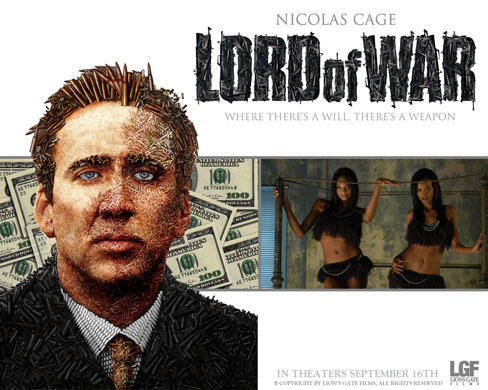“I hope they kill each other . . . too bad they both can’t lose.”
— Nobel laureate Henry Kissinger (on the U.S. arming both sides of the Iran-Iraq war in the 1980s)
“Do not support dictators. Do not sell them weapons.”
— Nobel laureate Jose Ramos Horta, East Timorese peace negotiator
It’s not every day Amnesty International asks me to go see a Nic Cage movie. So, when I got their e-mail about Lord of War, I promptly caught a bargain matinee at my local multiplex. This is not a movie review, but, by Hollywood standards, Lord of War rates R for radical: a film about the governments and freelancers supplying the weapons that kill men, women, and children every minute of every day.
According to the Federation of American Scientists:
- Half of the world’s governments spend more on defense than health care.
- The U.S. share of total world military expenditures per year has been roughly 36 percent, though the U.S. constitutes under 5 percent of the world’s population.
- The U.S. arms industry is the second most heavily subsidized industry after agriculture.
- 2001 world military expenditures topped $839 billion, while at the same time an estimated 1.3 billion people survive on less than the equivalent of $1 (U.S.) a day.
- The International Red Cross has estimated that one out of every two casualties of war is a civilian caught in the crossfire.
- According to the United Nations, there are now over 300,000 child soldiers around the world, now serving as combatants in over 30 current conflicts.
- The Center for International Policy estimates that about 80% of U.S. arms exports to the developing world go to non-democratic regimes.
- There are more landmines planted in Cambodia than people. Cambodia is just one of 64 countries around the world littered with some 100 million anti-personnel landmines. Intended primarily to maim, landmines can lie in wait years after a conflict ends, causing 500 deaths and injuries per week.
- The U.S. government is training soldiers in upwards of 70 countries at any given time.
“Since the end of the Second World War, tens of millions of people have been killed by conventional weapons, mostly small arms such as rifles, machine guns and rocket-propelled grenade launchers,” reports Lowell Bergman of Frontline (“Sierra Leone: Gallery of International Arms Dealers,” May 2002). “Low-tech, handheld weapons and explosives do the vast majority of the killing today. There are more than 550 million small arms currently in circulation, many of them fueling bloody civil strife in countries from Sri Lanka to Sierra Leone” (Bergman, May 2002)
And the home of the brave is the number one merchant of death. In 2004, the number two and number three weapons-exporting nations were France ($4.4 billion) and Russia ($4.6 billion). At number one was the United States at $18.5 billion . . . and if that number alone isn’t enough to provoke action, consider where those weapons are going.
“The U.S. has a long-standing (and accelerating) policy of arming, training, and aiding some of the world’s most repressive regimes,” says Frida Berrigan, Senior Research Associate with the Arms Trade Resource Center of the World Policy Institute (“U.S. Leads the World in Sale of Military Goods,” Ft. Worth Star-Telegram, 12 September 2005). “The U.S. transferred weaponry to 18 of the 25 countries involved in active conflicts in 2003, the last year for which full Pentagon data is available” (Berrigan, 12 September 2005).
I walked to the movie theater with no concern for landmines, snipers, or IEDs . . . but every foot that steps on a landmine somewhere in the Third World is blown off on our watch.
If nothing else, Lord of War shines a much-needed light on the deadly impact of arms trafficking. Anyone can take issue over certain aspects of the film, but what the mediocre reviews of the film — and there have been many of them — knowingly ignore is the daily price of the arms trade and the role Hollywood usually plays in fetishizing the use of weapons. Governor Arnold once said, “I have a love interest in every one of my films — a gun.” I say, as a tiny first step to countering business as usual, go see Lord of War instead of The 40-year-old Virgin this week and encourage others to do so. Do this not only to experience what Hollywood could do if it wanted but to vote with your movie dollar for a little less spectacle and a little more rabble-rousing at a theater near you.
 Mickey Z. is the author of several books including the soon-to-be-released There Is No Good War: The Myths of World War II (Vox Pop) and 50 American Revolutions You’re Not Supposed to Know: Reclaiming American Patriotism (Disinformation Books). This essay was excerpted from 50 American Revolutions You’re Not Supposed to Know. He can be found on the Web at <http://www.mickeyz.net>.
Mickey Z. is the author of several books including the soon-to-be-released There Is No Good War: The Myths of World War II (Vox Pop) and 50 American Revolutions You’re Not Supposed to Know: Reclaiming American Patriotism (Disinformation Books). This essay was excerpted from 50 American Revolutions You’re Not Supposed to Know. He can be found on the Web at <http://www.mickeyz.net>.

